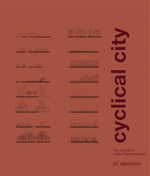Today, we are happy to bring you our conversation with Jill Desimini, author of CYCLICAL CITY: Five Stories of Urban Transformation, out this month.
*************
What inspired you to write this book?
As a kid growing up in Portland, Oregon, I used to walk in a place called Forest Park, a huge park that pushes into the center of the city. I loved that experience and remembered it years later when I began to visit cities where industry had departed, and wild urban woodlands sprang up on old factory landscapes. There was an idea that these landscapes heralded economic failure, but you could feel ecological potential. I guess you could say that out of those initial visceral appreciations came years of work addressing the systemic failures linked to urban abandonment, to both understand the political and economic ill will and to see these places as part of other, more positive stories.
We tend to categorize places as either experiencing economic growth or economic decline—in the case of cities as growing or shrinking—but all cities grow and shrink simultaneously. The situation is constantly changing with time. I wanted to understand this dynamism and in so doing, question the idea of linear march of progress. Through this questioning, I found incredible social and ecological value in what has been left fallow. It is in this fallow landscape that the idea of cycles—or the cyclical city—emerges.
What did you learn and what are you hoping readers will learn from your book?
I learned a lot about how long and intricate histories define the present condition of our cities, and I learned that what you might call unbuilding isn’t a negative operation at all. If readers take anything away from reading the book, then I hope they will learn to see that unexpected openings in the urban fabric are not holes, or tears, or losses. They are not gaps in what seem to be relentlessly one-way stories that we tell ourselves about cities. These opening are places to discover rich landscapes, new ideas about what is public, and a collective future.
What surprised you the most in the process of writing your book?
How many possible book titles I could go through! I think I went through something like ten or fifteen. I had lunch with an old friend recently who reminded me that the book was once called With Great Abandon, and now that seems as much of a title candidate—I loved the double meaning but, alas, nobody else did—as a title for my title process! Cyclical City works great, getting at the most important point: that there is no baseline urban condition, no single urban form to which we ought to aspire, but rather many places to return to and evolve from, without nostalgia. In a way, my struggle to find a title mimics what I am talking about: you can’t sum a city up, and you shouldn’t try.
What’s your favorite anecdote from your book?
The best part of the research was getting tours of places that were once written off by somebody or other and are now teeming with life. I loved trips to Lisbon, Portugal, to see the horticultural parks, and I was amazed by the Quinta da Granja, the Parque do Vale Fundão, and Parque do Vale Silêncio—maybe not truly forgotten spaces but ones where the interplay of light, topography, and plants embody the powerful qualities of the local landscape that Cyclical City is working to elevate. On my first day there, I tried to take a tram but there was a strike, so I took a cab and arrived late, only to find out that I wasn’t late but just in time for a delicious coffee and a drive through the outer hills. It left a wonderful impression of the open valleys and gave resonance to city’s ecological plans. Something to think about over a sardine dinner at El Rei D’Frango, itself perched mid-slope above Praça do Rossio.
What’s next?
Two things: how to grow the urban canopy on abandoned plots of land, and how to support climate justice activists, through the creation of a Climate Justice Design Fellowship. Coming soon at https://projects.iq.harvard.edu/climatefellowship.




